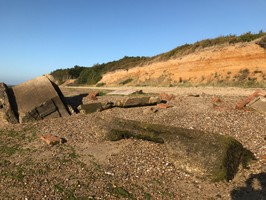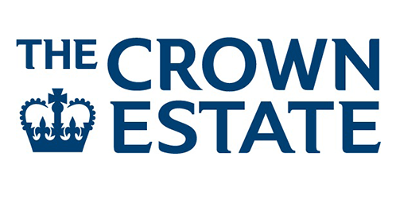PILLBOX
PILLBOX (25068)
- Easting
- 606744
- Northing
- 214689
The site of a Second World War hexagonal pillbox facing inland, with 6 embrasures and sunken covered entrance. It is located on the eastern edge of Mersea Island.
Field survey. 06, 07 and 08 November 2021. CITiZAN volunteers, C. Kolonko, D. Newman and O. Hutchinson.
Second World War hexagonal pillbox with central LAA well built to bullet-proof standard (0.38m thick walls). Sides of the pillbox measure approximately 2.80m. This pillbox is of an unknown design, often associated with Emergency Coast Artillery Batteries found in East Anglia, with examples known to have been constructed as far North as Hunstanton in Norfolk.
Although hexagonal in plan it is not built to the standard pillbox drawing FW3/22. The presence of a central Light Anti Aircraft gun well is not an indicator that the pillbox was built to drawing FW3/27 either, as it is hexagonal and not octagonal and the dimensions do not match those of the FW3/27 pillbox design.
Orientated facing North-West, with the entrance to the projecting annex facing North-North-East and entrance to the pillbox’s main chamber facing South-South-East. Embrasures for a light machine gun are found in each elevation, six in total, with these embrasures located in the following elevations and orientated towards the same direction: 1- North-North-West 2- North-East 3- East-South-East 4- South-South-East 5- South-West 6- West-North-West
The embrasures are reinforced on their external face with a 1cm (0.39in) thick armour plate which is bolted through the lower section of the embrasure and also cast into the pillbox using bolts. This plate reinforces the relatively thin sides of the embrasure, which without such a plate would not withstand heavy small arms fire or other projectiles for very long. The sides of the embrasure are much thinner than the required 0.38m thick reinforced concrete walls that are required to ensure bullet-proof standard. On the interior, the embrasures are splayed with a lower recess to accept the bipod of a Light Machine Gun, likely the Bren. Sections of T-shaped bar have been cast through the pillbox wall, to provide support for a shelf on the interior walls. This bar has caused spalling of the outer surface, revealing the bar is cast through the pillbox’s walls. These embrasures would have provided an approximate arc of fire of 60 degrees laterally. It is worth noting that the cramped interior of the pillbox would have meant that any soldier firing a LMG from within the pillbox would apparently have limited space to operate the weapon and may have had to place the muzzle of the machine gun out of the embrasure. This is something that needs to be confirmed through experimental archaeology.
The central open well for a light anti aircraft gun, again likely to be the Bren or Lewis gun, is hexagonal in plan and also acts as an anti-ricochet wall for the pillbox. In the centre of this well is a cylindrical pedestal with a square post for mounting the gun. The lower cylindrical pedestal in this example appears to have been cast using wooden shuttering, which has left flat impressions in the cylinder. The position offers uninterrupted arcs and viewsheds across 360 degrees, which would have been essential to leading and engaging incoming aircraft. Soldiers occupying this position would not have been massively exposed, with only the head above the top of the pillbox, though space would have been limited in the position with the two-soldier crew required to operate the gun. Firing from this position with a Light Machine Gun would have offered limited protection from air attack, other than engaging low flying aircraft.
The edge of the open well is surrounded by a lip of concrete, which would have provided some protection from water ingress into the open position. This lip of concrete appears to have been added after construction of the pillbox was completed. An additional inverted V-shaped section of metal also covers the East facing entrance to the anti-aircraft well, to minimise water ingress into the interior of the pillbox.
A series of square vents are located in the upper centre of each internal surface of the well. These slope downwards from the exterior to interior. Initially it was thought that these were for firing weapons from the interior of the pillbox to the outside, possibly covering the roof. However, in field experimentation using a ranging pole revealed that it would not only be next to impossible to place and fire a weapon through these vents, there was no chance of aiming at or leading a target due to the lack of available space. It was concluded during the survey that these square holes are for providing ventilation for the pillbox’s sealed interior.
The entrance to the pillbox’s main chamber is covered by an integral annex attached to the East-South-East facing elevation. The walls of this annex are again built to bullet proof standard, though the roof is thinner. The roof of the annex features three steps that slope the roof downwards from the side of the pillbox. This feature was possibly to ensure rain would drain off the roof, and also allow some degree of depression from a weapon employed in the East-South-East facing embrasure. Steps provide entry to the entrance and these steps are surrounded by a low retaining wall of concrete. The interior of the annex’s shortest wall is ridged due to the shuttering used to cast the structure. This gives the impression of corrugated metal shuttering but is indeed wooden planks set on edge, possibly to facilitate removal of the wooden shuttering after the concrete had set.
The pillbox is constructed from reinforced concrete throughout, cast using wooden shuttering.
From this position the pillbox is sited on a slight rise, giving it an elevated position overlooking the surrounding landscape. The pillbox was capable of covering the surrounding landscape over 360 degrees from the position, with the primary task being to protect the approaches to the East Mersea Battery from the North-West and its perimeter, though the pillbox could also cover the approaches from the coast. This would have been key to protecting the battery from an attack inland, possibly by infantry landed inland by parachute, glider or aircraft.
- Period
- Modern (1901 and later)
- Period comments
Second World War
- The earliest date of the feature, as a year, if known
- 1940
- The latest date of the feature, as a year, if known
- 1942
- Monument Type - Broad
- PILLBOX (VARIANT)|PILLBOX
- Monument Type - Narrow
- Monument Description
- Evidence Type - Broad
- Evidence Type - Narrow
- Evidence Description
- Object Type - Broad
- Object Type - Narrow
- Object Description
- Height OD (m)
- How accessible is the feature?
- Easily accessible - no restrictions
- Accessibility comments
Other records:
- NRHE Number
- 1429718
- NT HBSMR Number
- Unknown
- HER Event Number
- Unknown
- External Link
- None
Over to you...
If you know there are errors in the original feature record above, you can edit the original record
If you would like to visit the feature and carry out a 'Feature Update Survey', you can prepare a 'Feature Update Survey' pack for this feature (in PDF format)
If you have completed a 'Feature Update Survey' for this feature, you can submit your 'Feature Update Survey'
If you want to use your smart phone to carry out the 'Feature Update Survey', you can download the CITiZAN smart app.
Feature Update Surveys
5 surveys accepted and 0 pending.
Click on a survey to expand it.
- Date of survey
- 12th September, 2019
- Feature located?
- State of the tide
- Proximity to coast edge
- Coastal processes
- Is there a coastal defence?
- Other threats?
- If other, please specify
- How visible are the remains? ABOVE GROUND
- How visible are the remains in the face of the cliff, ridge or dune? IN SECTION
- Do you know if the feature is?
- What actions (if any) would you recommend for this feature?
- Do you have any other comments?
- Date of survey
- 6th November, 2021
- Feature located?
- State of the tide
- Proximity to coast edge
- Coastal processes
- Is there a coastal defence?
- Other threats?
- If other, please specify
- How visible are the remains? ABOVE GROUND
- How visible are the remains in the face of the cliff, ridge or dune? IN SECTION
- Do you know if the feature is?
- What actions (if any) would you recommend for this feature?
- Do you have any other comments?
Measured survey of this pillbox required.
- Date of survey
- 6th November, 2021
- Feature located?
- State of the tide
- Proximity to coast edge
- Coastal processes
- Is there a coastal defence?
- Other threats?
- If other, please specify
- How visible are the remains? ABOVE GROUND
- How visible are the remains in the face of the cliff, ridge or dune? IN SECTION
- Do you know if the feature is?
- What actions (if any) would you recommend for this feature?
- Do you have any other comments?
- Date of survey
- 8th November, 2021
- Feature located?
- State of the tide
- Proximity to coast edge
- Coastal processes
- Is there a coastal defence?
- Other threats?
- If other, please specify
- How visible are the remains? ABOVE GROUND
- How visible are the remains in the face of the cliff, ridge or dune? IN SECTION
- Do you know if the feature is?
- What actions (if any) would you recommend for this feature?
- Do you have any other comments?
- Date of survey
- 8th November, 2021
- Feature located?
- State of the tide
- Proximity to coast edge
- Coastal processes
- Is there a coastal defence?
- Other threats?
- If other, please specify
- How visible are the remains? ABOVE GROUND
- How visible are the remains in the face of the cliff, ridge or dune? IN SECTION
- Do you know if the feature is?
- What actions (if any) would you recommend for this feature?
- Do you have any other comments?
Photos

Pillbox by ChrisKolonko

Pillbox by ChrisKolonko

Pillbox by ChrisKolonko

Pillbox by ChrisKolonko

Pillbox by ChrisKolonko

Pillbox by ChrisKolonko

Pillbox by ChrisKolonko

Pillbox by ChrisKolonko

Pillbox by ChrisKolonko

Pillbox by ChrisKolonko

Pillbox by ChrisKolonko

Pillbox by ChrisKolonko

Pillbox by ChrisKolonko










